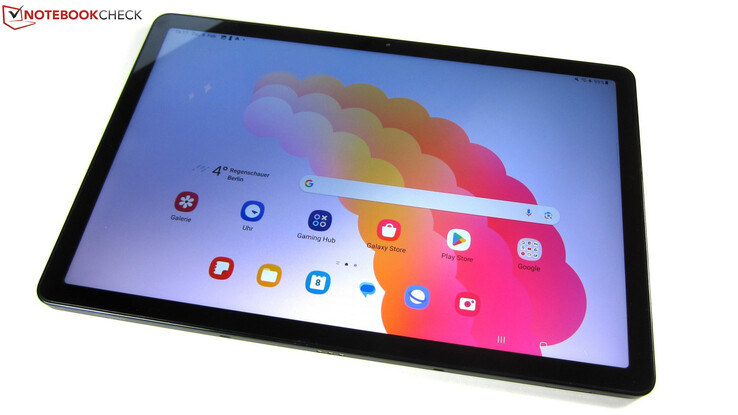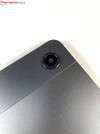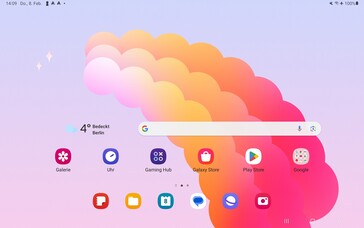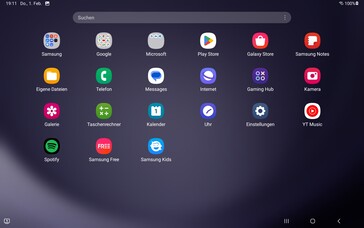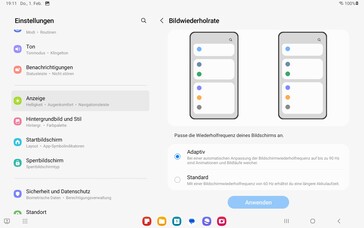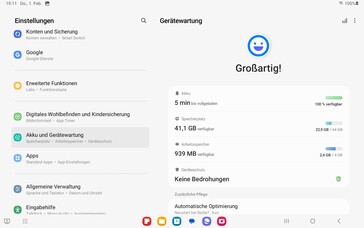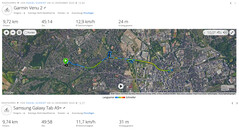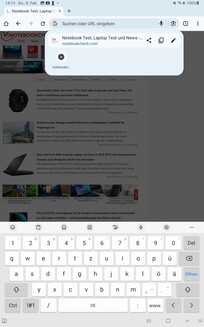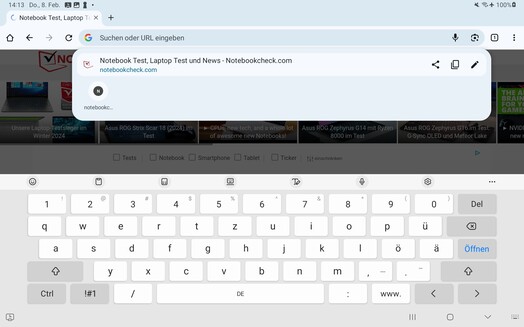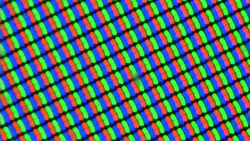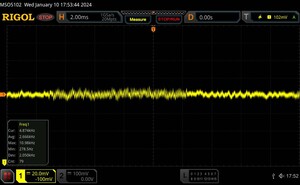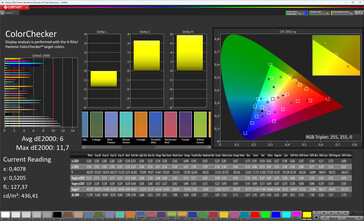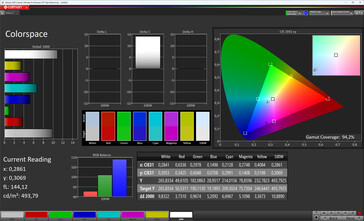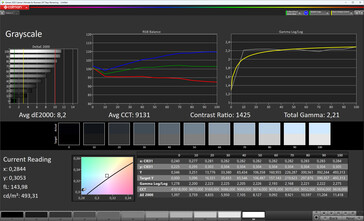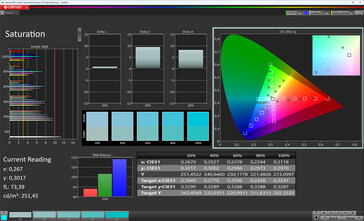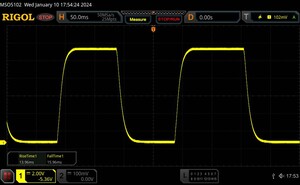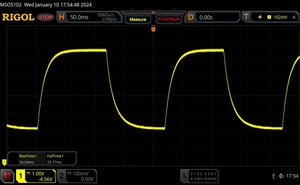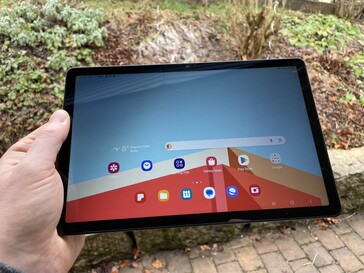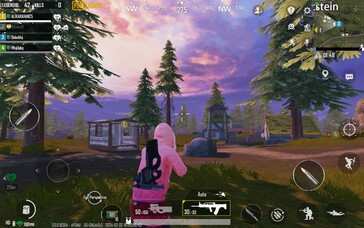Samsung Galaxy Tab A9+ review - The 90-Hz tablet with 4 years of updates leaves little more to wish for
The Galaxy Tab series features some of Samsung's most inexpensive tablets. Its newest addition is the 11-inch Galaxy Tab A9+ which replaces its 10.5-inch predecessor, the Galaxy Tab A8. It not only features a larger screen size, but its extensive features have also been given a refresh.
The Snapdragon 695 5G runs inside the Samsung Galaxy Tab A9+, replacing the slower Unisoc T618. Furthermore, the tablet now starts with 64 GB of storage instead of 32 GB. Its refresh rate is excellent for a tablet within this price class—it used to be 60 Hz and now it is 90 Hz. The Galaxy Tab A9+ is also the first Galaxy Tab A model to offer a 5G version. Its slower 8.7-inch sister model, the Galaxy Tab A9, is limited to LTE and 60 Hz.
The smallest configuration of the Samsung Galaxy Tab A9+ has a starting price of US$219.99. It also comes as a kids edition with a protective case and a stylus pen, which aims to create a safe and fun tablet environment. At the moment, you can only get this version in certain countries.
Possible competitors compared
Rating | Date | Model | Weight | Height | Size | Resolution | Price |
|---|---|---|---|---|---|---|---|
| 84.2 % v7 (old) | 02 / 2024 | Samsung Galaxy Tab A9+ SD 695 5G, Adreno 619 | 480 g | 6.9 mm | 11.00" | 1920x1200 | |
| 81.7 % v7 (old) | 11 / 2022 | Honor Pad 8 SD 680, Adreno 610 | 520 g | 6.9 mm | 12.00" | 2000x1200 | |
| 83.5 % v7 (old) | 01 / 2024 | Xiaomi Redmi Pad SE SD 680, Adreno 610 | 481 g | 7.36 mm | 11.00" | 1920x1200 | |
| 81 % v7 (old) | 02 / 2022 | Samsung Galaxy Tab A8 2022 T618, Mali-G52 MP2 | 508 g | 6.9 mm | 10.50" | 1920x1200 | |
| 79.4 % v7 (old) | 01 / 2024 | Teclast M50 HD T7200 (T606), Mali-G57 MP1 | 435 g | 8 mm | 10.10" | 1920x1200 | |
| 81.5 % v7 (old) | 09 / 2023 | Telekom T Tablet Dimensity 700, Mali-G57 MP2 | 490 g | 7.8 mm | 10.40" | 2000x1200 |
Case - The Galaxy Tab A9+ with an aluminum case
When it comes to the Samsung Galaxy Tab A9+'s design, not much has changed compared to its predecessor, as the 11-inch tab continues to be clad in an attractive and well-built aluminum case which gives the device great stability. Our WiFi version is quite light for a tablet of this size, weighing 480 grams.
The metal surface on the back is only interrupted near the height of its 8-MP camera. There, a plastic strip stretches across the entire width of the 6.9-millimeter flat tablet, behind which the wireless antennas are concealed. At 491 grams, the 5G version weighs slightly more than our WiFi test version.
The Galaxy Tab A9+'s bezels have a thickness of around 0.9 centimetres. This means you can comfortably hold the tablet in your hands while avoiding activating the touchscreen by accident. The Samsung tablet's display-to-surface ratio is good at 81 per cent, which is a further improvement on the screen-to-body ratio of its predecessor (Galaxy Tab A8: 80%).
Samsung offers the Galaxy Tab A9+ in the colors Graphite, Silver and Navy. All three color variants feature a matte back cover that conceals fingerprint marks quite well.
Connectivity - The Samsung tablet with up to 128 GB of storage and 5G
The Galaxy Tab A9+ has adopted a lot of connectivity features from its predecessor. Its WLAN module continues to rely on WiFi 5 and its OTG-enabled USB-C port still has USB 2.0 speeds, which also means wired image output isn't possible using this connection. In turn, it has also kept features such as the 3.5-mm audio jack and its four speakers with Dolby Atmos certification. Connected to the Samsung 980 Pro external SSD, the USB-C port achieved a data throughput of 32.4 MByte/s, which corresponds to classic USB 2.0 speeds.
Its biggest innovation is in mobile communications, as the Galaxy Tab A9+ can now also be had as an optional 5G version for the first time. This means there are a total of four tablet configurations to choose from:
• Galaxy Tab A9+ Wi-Fi 64 GB: US$219.99
• Galaxy Tab A9+ Wi-Fi 128 GB: US$269.99
• Galaxy Tab A9+ 5G 64 GB: US$269.99
• Galaxy Tab A9+ 5G 128 GB: US$269.99
The Galaxy Tab A9+'s microSD card slot accepts cards up to 1 TB in size. However, the latter cannot be formatted as internal storage, making it difficult to install large games collections—especially on the 64 GB configurations. What's more, Android 13 and the pre-installed apps take up almost 23 GB on our test device, leaving just under 41 GB free when freshly installed.
microSD card reader
The microSD card slot is faster than average compared to the tablet's price class and only just beat the Galaxy Tab A8 in our copying test, achieving a peak value of 47.2 MB/s. When used with our Angelbird AV Pro V60 reference card, the Galaxy Tab A9+ also achieved good and largely stable transfer rates when it came to sequential reading and writing.
| SD Card Reader - average JPG Copy Test (av. of 3 runs) | |
| Samsung Galaxy Tab A8 2022 (Angelbird AV Pro V60) | |
| Samsung Galaxy Tab A9+ (Angelbird AV Pro V60) | |
| Teclast M50 HD (Angelbird V60) | |
| Xiaomi Redmi Pad SE (Angelbird AV Pro V60) | |
| Telekom T Tablet (Angelbird AV Pro V60) | |
Cross Platform Disk Test (CPDT)
Software - The first Galaxy-A tablet with Samsung DeX
Samsung's in-house user interface, version 5.1 of One UI, runs on the Galaxy Tab A9+. At the time of testing, it was based on Android 13 and the latest Android security patch was from October 2023. The Galaxy Tab A9+ is set to see two generations of OS upgrades and 4 years' worth of security updates.
Different to its 8.7-inch sister model, the Galaxy Tab A9, the Galaxy Tab A9+ can also make use of the Samsung DeX interface which was previously only reserved for Galaxy Tab S tablets. This switches the Galaxy Tab A9+ into a desktop mode similar to a PC. External monitors may not be supported on the Galaxy Tab A9+ with DeXm, however, the tablet can still comfortably be operated using a mouse and keyboard.
Mouse and keyboard work just fine using the normal One-UI view as well, in which 3 apps can be open simultaneously in split-screen mode—the same as when using DeX. Alternatively, you can open apps in pop-up windows whose size and position can then be adjusted. Content can additionally be mirrored to compatible end devices such as smart TVs using Smart View.
Samsung provides its tablet with a number of security features via the Samsung Knox security platform. Data protection settings can be defined in detail and content can be encrypted before it is sent. The tablet can also connect securely to public WiFi networks. Data traffic is encrypted and tracking apps are blocked.
Communication and GNSS - The Galaxy Tab A9+ with WiFi 5 and good GPS
The Samsung Galaxy Tab A9+ supports the IEEE standard 802.11a/b/g/n/ac aka WiFi 5, meaning it can connect to 2.4-GHz and 5-GHz WLAN. The 5G version of the tablet can also connect to the web using mobile data.
In our test using the Asus ROG Rapture GT-AXE11000 as a reference router, the tablet achieved typical transfer rates for WiFi 5. It achieved peaks of 369 MBit/s and it remained constant when sending and receiving.
| Networking | |
| iperf3 receive AXE11000 | |
| Telekom T Tablet | |
| Honor Pad 8 | |
| Samsung Galaxy Tab A9+ | |
| Samsung Galaxy Tab A8 2022 | |
| Xiaomi Redmi Pad SE | |
| Teclast M50 HD | |
| iperf3 transmit AXE11000 | |
| Telekom T Tablet | |
| Xiaomi Redmi Pad SE | |
| Samsung Galaxy Tab A9+ | |
| Teclast M50 HD | |
| Honor Pad 8 | |
| Samsung Galaxy Tab A8 2022 | |
The Samsung Galaxy Tab A9+ uses the single-band navigation services GPS, Glonass, Galileo and Beidou, and is therefore accurate to within 3 meters outdoors. In motion, its precision remains surprisingly high for a tablet in this price range. Compared to the Garmin Venu 2 fitness smartwatch, the Samsung tablet recorded the route of our 10-kilometer bike ride almost as accurately. So if you want to use the Galaxy Tab A9+ as an extra-large navigation device, the tablet won't give you any reason not to.
Cameras - decent selfie camera, disappointing main camera
The Galaxy Tab A9+'s selfie camera has a resolution of 5 MP, making it better than the Galaxy Tab A9's front-facing camera with a resolution of only 2 MP. During our test, it took decent selfies in good lighting conditions and with portrait mode activated, it showed nice levels of bokeh effects when photographing our subjects. Videos can be recorded in up to Full HD and at 30 fps using the selfie cam as well as the main camera.
The main camera has an 8-MP resolution and an autofocus. In daylight, it takes decent photos and depicts colors quite neutrally. As a result of its harsh sharpening, smaller details are unfortunately often lost, which in turn leads to these parts of the images appearing somewhat blurry.
If the lighting conditions are no longer optimal, the main camera is visibly pushed to its limits. This was also the case in the cloudy weather we had to deal with at the time of testing, making the images look rather dull at times. In low-light conditions, the main camera is no longer usable at all. However, anyone who mainly uses the 8 MP lens to take photos of documents and texts should be satisfied with its photography skills.
Image comparison
Choose a scene and navigate within the first image. One click changes the position on touchscreens. One click on the zoomed-in image opens the original in a new window. The first image shows the scaled photograph of the test device.
Daylight photo 1Daylight photo 25x zoomLow-light photoUnder controlled lighting conditions, the main camera reproduced the ColorChecker card colors very accurately with optimal lighting. It also reproduced the test chart sharply. Unfortunately, the exact opposite was the case with 1 lux of residual light, as the color chart and the test chart then disappeared in the dark.
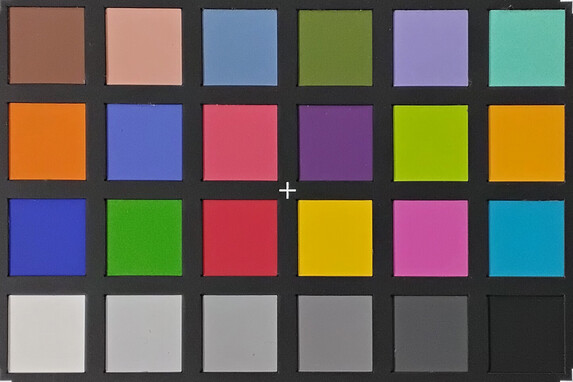

Accessories and warranty - 24-month warranty and Samsung Care+
Samsung delivers its tablet with a USB-C cable, a SIM tool as well as a short manual and an additional leaflet laying out the tablet's warranty. You have to buy a compatible power supply yourself—on Samsung's online shop, for example, you can get a 15-watt charger for around US$20. The manufacturer offers a variety of book covers for the tablet.
The Samsung Galaxy Tab A9+ is covered by a 24-month warranty. It can be expanded via Samsung Care+. You can add up to 2 years and it also covers accidental damage such as a cracked display, and it can be expanded to also cover theft. Depending on the selected package, Samsung Care+ costs between US$25 and US$65.
Input devices & operation - Smooth depiction thanks to a 90-Hz panel
The Galaxy Tab A9+'s screen responds to inputs precisely and without any noticeable delays. The tablet doesn't support pen input. It benefits from a 90-Hz screen which displays animations much more smoothly than similarly priced 60-Hz competitors. Among the comparison devices, the Xiaomi Redmi Pad SE also features a 90-Hz display.
The Samsung tablet doesn't have a fingerprint sensor. Biometric login is only possible via a 2D facial scan, but it isn't considered particularly secure as it can be tricked quite easily. On the other hand, facial recognition works quickly and with a high accuracy rate even in low lighting conditions.
Display - LC display without PWM
The tablet's 11-inch display has a resolution of 1920 x 1200 pixels and an aspect ratio of 16:10, giving it a pixel density of 206 PPI. When it comes to brightness, the Galaxy Tab A9+ has improved quite a bit compared to its predecessor.
The Galaxy Tab A9+'s LCD-TFT panel achieves a maximum brightness of 493 cd/m² when depicting a full white screen. When displaying an even distribution of light and dark areas (APL18 measurement), it reaches almost the same levels—namely 492 cd/m². This also doesn't change when you adapt the brightness manually. If you do so, you can expect brightness levels up to 490 cd/m². Using the lowest brightness setting leads to values around 3.7 cd/m².
The display doesn't use any pulse-width modulation (PWM) to dim the display. This makes the tablet ideal for users who may react sensitively to PWM flickering.
| |||||||||||||||||||||||||
Brightness Distribution: 90 %
Center on Battery: 493 cd/m²
Contrast: 1409:1 (Black: 0.35 cd/m²)
ΔE ColorChecker Calman: 6 | ∀{0.5-29.43 Ø4.78}
ΔE Greyscale Calman: 8.2 | ∀{0.09-98 Ø5}
94.2% sRGB (Calman 2D)
Gamma: 2.21
CCT: 9131 K
| Samsung Galaxy Tab A9+ TFT-LCD, 1920x1200, 11" | Honor Pad 8 IPS, 2000x1200, 12" | Xiaomi Redmi Pad SE TFT-LCD, 1920x1200, 11" | Samsung Galaxy Tab A8 2022 TFT-LCD, 1920x1200, 10.5" | Teclast M50 HD IPS, 1920x1200, 10.1" | Telekom T Tablet TFT-LCD, 2000x1200, 10.4" | |
|---|---|---|---|---|---|---|
| Screen | 2% | 24% | -23% | -22% | -24% | |
| Brightness middle (cd/m²) | 493 | 379 -23% | 473 -4% | 368 -25% | 246 -50% | 529 7% |
| Brightness (cd/m²) | 460 | 382 -17% | 449 -2% | 346 -25% | 227 -51% | 486 6% |
| Brightness Distribution (%) | 90 | 84 -7% | 85 -6% | 91 1% | 88 -2% | 87 -3% |
| Black Level * (cd/m²) | 0.35 | 0.3 14% | 0.28 20% | 0.61 -74% | 0.33 6% | 0.56 -60% |
| Contrast (:1) | 1409 | 1263 -10% | 1689 20% | 603 -57% | 745 -47% | 945 -33% |
| Colorchecker dE 2000 * | 6 | 4.76 21% | 3 50% | 6.9 -15% | 6.28 -5% | 9.6 -60% |
| Colorchecker dE 2000 max. * | 11.7 | 9.25 21% | 6 49% | 11.4 3% | 14.1 -21% | 14.4 -23% |
| Greyscale dE 2000 * | 8.2 | 6.7 18% | 2.7 67% | 7.7 6% | 8.8 -7% | 10.5 -28% |
| Gamma | 2.21 100% | 2.234 98% | 2.27 97% | 2.16 102% | 2.277 97% | 2.17 101% |
| CCT | 9131 71% | 8468 77% | 6589 99% | 8547 76% | 8024 81% | 10482 62% |
* ... smaller is better
Screen Flickering / PWM (Pulse-Width Modulation)
| Screen flickering / PWM not detected | |||
In comparison: 53 % of all tested devices do not use PWM to dim the display. If PWM was detected, an average of 8142 (minimum: 5 - maximum: 343500) Hz was measured. | |||
The Galaxy Tab A9+'s screen missed the mark in terms of color calibration. Both colors and grayscale are clearly not ideal, with the latter also showing a blue tint. In everyday use, however, you likely won't notice these less-than-ideal preset image parameters much. All the more noticeable, on the other hand, is the screen's good color reproduction thanks to its contrast ratio of around 1400:1. However, you can't adjust any of the picture parameters yourself—not even the color temperature.
Display Response Times
| ↔ Response Time Black to White | ||
|---|---|---|
| 29.92 ms ... rise ↗ and fall ↘ combined | ↗ 13.96 ms rise | |
| ↘ 15.96 ms fall | ||
| The screen shows relatively slow response rates in our tests and may be too slow for gamers. In comparison, all tested devices range from 0.1 (minimum) to 240 (maximum) ms. » 79 % of all devices are better. This means that the measured response time is worse than the average of all tested devices (20.2 ms). | ||
| ↔ Response Time 50% Grey to 80% Grey | ||
| 53.81 ms ... rise ↗ and fall ↘ combined | ↗ 24.04 ms rise | |
| ↘ 29.77 ms fall | ||
| The screen shows slow response rates in our tests and will be unsatisfactory for gamers. In comparison, all tested devices range from 0.165 (minimum) to 636 (maximum) ms. » 90 % of all devices are better. This means that the measured response time is worse than the average of all tested devices (31.7 ms). | ||
The Galaxy Tab A9+'s TFT LCD doesn't do too bad a job outside. Due to its harsh screen reflections, however, it is definitely better suited to being used indoors. Content can still be viewed clearly from very flat angles. If you don't hold the tablet perpendicular to your viewing direction, the screen darkens. Still, its overall drop in brightness is moderate.
Performance - The Galaxy Tab A9+ with a Snapdragon 695 5G
The mid-range Snapdragon 695 5G SoC helps give the Galaxy Tab A9+ solid system performance. In everyday use, it almost always ensures smooth operation—with a dropped frame or two in rare cases, such as directly after booting up the system. Thanks to its 4 GB RAM, the tablet doesn't near its limits even with lots of apps open at once.
| AImark - Score v3.x | |
| Average of class Tablet (138 - 55794, n=55, last 2 years) | |
| Average Qualcomm Snapdragon 695 5G (426 - 3080, n=7) | |
| Samsung Galaxy Tab A9+ | |
| Xiaomi Redmi Pad SE | |
| Teclast M50 HD | |
| UL Procyon AI Inference for Android - Overall Score NNAPI | |
| Average of class Tablet (2597 - 76852, n=65, last 2 years) | |
| Telekom T Tablet | |
| Average Qualcomm Snapdragon 695 5G (5442 - 9348, n=15) | |
| Samsung Galaxy Tab A9+ | |
| Honor Pad 8 | |
| Xiaomi Redmi Pad SE | |
| Teclast M50 HD | |
The Snapdragon 695 5G houses the Adreno 619 GPU which helps make the tablet one of the best-performing systems within the comparison field. Its strongest competitor is the Telekom T Tablet, but it didn't manage to beat the other test candidates during any of the benchmarks.
GFXBench (DX / GLBenchmark) 2.7: T-Rex Onscreen | 1920x1080 T-Rex Offscreen
GFXBench 3.0: on screen Manhattan Onscreen OGL | 1920x1080 1080p Manhattan Offscreen
GFXBench 3.1: on screen Manhattan ES 3.1 Onscreen | 1920x1080 Manhattan ES 3.1 Offscreen
GFXBench: on screen Car Chase Onscreen | 1920x1080 Car Chase Offscreen | on screen Aztec Ruins High Tier Onscreen | 2560x1440 Aztec Ruins High Tier Offscreen | on screen Aztec Ruins Normal Tier Onscreen | 1920x1080 Aztec Ruins Normal Tier Offscreen | 3840x2160 4K Aztec Ruins High Tier Offscreen
| 3DMark / Wild Life Extreme Unlimited | |
| Samsung Galaxy Tab A9+ | |
| Telekom T Tablet | |
| Samsung Galaxy Tab A8 2022 | |
| Honor Pad 8 | |
| Xiaomi Redmi Pad SE | |
| Teclast M50 HD | |
| 3DMark / Wild Life Extreme | |
| Samsung Galaxy Tab A9+ | |
| Telekom T Tablet | |
| Samsung Galaxy Tab A8 2022 | |
| Honor Pad 8 | |
| Xiaomi Redmi Pad SE | |
| Teclast M50 HD | |
| 3DMark / Wild Life Unlimited Score | |
| Samsung Galaxy Tab A9+ | |
| Telekom T Tablet | |
| Samsung Galaxy Tab A8 2022 | |
| Xiaomi Redmi Pad SE | |
| Honor Pad 8 | |
| Teclast M50 HD | |
| 3DMark / Wild Life Score | |
| Samsung Galaxy Tab A9+ | |
| Telekom T Tablet | |
| Samsung Galaxy Tab A8 2022 | |
| Xiaomi Redmi Pad SE | |
| Honor Pad 8 | |
| Teclast M50 HD | |
| 3DMark / Sling Shot Extreme (ES 3.1) Unlimited | |
| Samsung Galaxy Tab A9+ | |
| Telekom T Tablet | |
| Samsung Galaxy Tab A8 2022 | |
| Xiaomi Redmi Pad SE | |
| Honor Pad 8 | |
| Teclast M50 HD | |
| 3DMark / Sling Shot Extreme (ES 3.1) Unlimited Graphics | |
| Samsung Galaxy Tab A9+ | |
| Telekom T Tablet | |
| Xiaomi Redmi Pad SE | |
| Samsung Galaxy Tab A8 2022 | |
| Honor Pad 8 | |
| Teclast M50 HD | |
| 3DMark / Sling Shot Extreme (ES 3.1) Unlimited Physics | |
| Telekom T Tablet | |
| Samsung Galaxy Tab A9+ | |
| Samsung Galaxy Tab A8 2022 | |
| Honor Pad 8 | |
| Teclast M50 HD | |
| Xiaomi Redmi Pad SE | |
| GFXBench (DX / GLBenchmark) 2.7 / T-Rex Onscreen | |
| Samsung Galaxy Tab A9+ | |
| Telekom T Tablet | |
| Samsung Galaxy Tab A8 2022 | |
| Xiaomi Redmi Pad SE | |
| Honor Pad 8 | |
| Teclast M50 HD | |
| GFXBench (DX / GLBenchmark) 2.7 / T-Rex Offscreen | |
| Samsung Galaxy Tab A9+ | |
| Telekom T Tablet | |
| Samsung Galaxy Tab A8 2022 | |
| Honor Pad 8 | |
| Xiaomi Redmi Pad SE | |
| Teclast M50 HD | |
| GFXBench 3.0 / Manhattan Onscreen OGL | |
| Samsung Galaxy Tab A9+ | |
| Telekom T Tablet | |
| Samsung Galaxy Tab A8 2022 | |
| Xiaomi Redmi Pad SE | |
| Honor Pad 8 | |
| Teclast M50 HD | |
| GFXBench 3.0 / 1080p Manhattan Offscreen | |
| Samsung Galaxy Tab A9+ | |
| Telekom T Tablet | |
| Samsung Galaxy Tab A8 2022 | |
| Honor Pad 8 | |
| Xiaomi Redmi Pad SE | |
| Teclast M50 HD | |
| GFXBench 3.1 / Manhattan ES 3.1 Onscreen | |
| Samsung Galaxy Tab A9+ | |
| Telekom T Tablet | |
| Samsung Galaxy Tab A8 2022 | |
| Xiaomi Redmi Pad SE | |
| Honor Pad 8 | |
| Teclast M50 HD | |
| GFXBench 3.1 / Manhattan ES 3.1 Offscreen | |
| Samsung Galaxy Tab A9+ | |
| Telekom T Tablet | |
| Samsung Galaxy Tab A8 2022 | |
| Honor Pad 8 | |
| Xiaomi Redmi Pad SE | |
| Teclast M50 HD | |
| GFXBench / Car Chase Onscreen | |
| Samsung Galaxy Tab A9+ | |
| Telekom T Tablet | |
| Samsung Galaxy Tab A8 2022 | |
| Xiaomi Redmi Pad SE | |
| Honor Pad 8 | |
| Teclast M50 HD | |
| GFXBench / Car Chase Offscreen | |
| Samsung Galaxy Tab A9+ | |
| Telekom T Tablet | |
| Samsung Galaxy Tab A8 2022 | |
| Honor Pad 8 | |
| Xiaomi Redmi Pad SE | |
| Teclast M50 HD | |
| GFXBench / Aztec Ruins High Tier Onscreen | |
| Samsung Galaxy Tab A9+ | |
| Telekom T Tablet | |
| Samsung Galaxy Tab A8 2022 | |
| Xiaomi Redmi Pad SE | |
| Honor Pad 8 | |
| Teclast M50 HD | |
| GFXBench / Aztec Ruins High Tier Offscreen | |
| Samsung Galaxy Tab A9+ | |
| Telekom T Tablet | |
| Samsung Galaxy Tab A8 2022 | |
| Xiaomi Redmi Pad SE | |
| Honor Pad 8 | |
| Teclast M50 HD | |
| GFXBench / Aztec Ruins Normal Tier Onscreen | |
| Samsung Galaxy Tab A9+ | |
| Telekom T Tablet | |
| Samsung Galaxy Tab A8 2022 | |
| Xiaomi Redmi Pad SE | |
| Honor Pad 8 | |
| Teclast M50 HD | |
| GFXBench / Aztec Ruins Normal Tier Offscreen | |
| Samsung Galaxy Tab A9+ | |
| Telekom T Tablet | |
| Samsung Galaxy Tab A8 2022 | |
| Xiaomi Redmi Pad SE | |
| Honor Pad 8 | |
| Teclast M50 HD | |
| GFXBench / 4K Aztec Ruins High Tier Offscreen | |
| Samsung Galaxy Tab A9+ | |
| Telekom T Tablet | |
| Honor Pad 8 | |
| Xiaomi Redmi Pad SE | |
| Teclast M50 HD | |
The Galaxy Tab A9+ loads websites quickly. This was also reflected in the browser tests, where the tablet beat the competition in every benchmark.
| Jetstream 2 - 2.0 Total Score | |
| Average of class Tablet (22.3 - 395, n=69, last 2 years) | |
| Samsung Galaxy Tab A9+ (Chrome 121.0.6167.143) | |
| Average Qualcomm Snapdragon 695 5G (48.6 - 105.3, n=19) | |
| Telekom T Tablet (chrome 116) | |
| Xiaomi Redmi Pad SE (chrome 116) | |
| Teclast M50 HD (Chrome 120) | |
| Honor Pad 8 (Chrome 106.0.5249.126) | |
| Samsung Galaxy Tab A8 2022 (Chrome 94.0.4606.85) | |
| WebXPRT 4 - Overall | |
| Average of class Tablet (26 - 376, n=74, last 2 years) | |
| Samsung Galaxy Tab A9+ (Chrome 121.0.6167.143) | |
| Average Qualcomm Snapdragon 695 5G (58 - 111, n=18) | |
| Xiaomi Redmi Pad SE (chrome 116) | |
| Telekom T Tablet (chrome 116) | |
| Teclast M50 HD (Chrome 120) | |
| Honor Pad 8 (Chrome 106.0.5249.126) | |
| WebXPRT 3 - Overall | |
| Average of class Tablet (39 - 480, n=27, last 2 years) | |
| Samsung Galaxy Tab A9+ (Chrome 121.0.6167.143) | |
| Average Qualcomm Snapdragon 695 5G (75 - 156, n=12) | |
| Xiaomi Redmi Pad SE (chrome 116) | |
| Samsung Galaxy Tab A8 2022 (Chrome 94.0.4606.85) | |
| Honor Pad 8 (Chrome 106.0.5249.126) | |
| Speedometer 2.0 - Result 2.0 | |
| Average of class Tablet (2.59 - 790, n=58, last 2 years) | |
| Samsung Galaxy Tab A9+ (Chrome 121.0.6167.143) | |
| Average Qualcomm Snapdragon 695 5G (38.7 - 80.1, n=16) | |
| Xiaomi Redmi Pad SE (chrome 116) | |
| Honor Pad 8 (Chrome 106.0.5249.126) | |
| Teclast M50 HD (Chrome 120) | |
| Samsung Galaxy Tab A8 2022 (Chrome 94.0.4606.85) | |
| Octane V2 - Total Score | |
| Average of class Tablet (763 - 138481, n=98, last 2 years) | |
| Samsung Galaxy Tab A9+ (Chrome 121.0.6167.143) | |
| Average Qualcomm Snapdragon 695 5G (17849 - 31647, n=21) | |
| Telekom T Tablet (chrome 116) | |
| Xiaomi Redmi Pad SE (chrome 120) | |
| Honor Pad 8 (Chrome 106.0.5249.126) | |
| Teclast M50 HD (Chrome 120) | |
| Samsung Galaxy Tab A8 2022 (Chrome 94.0.4606.85) | |
| Mozilla Kraken 1.1 - Total | |
| Samsung Galaxy Tab A8 2022 (Chrome 94.0.4606.85) | |
| Teclast M50 HD (Chrome 120) | |
| Honor Pad 8 (Chrome 106.0.5249.126) | |
| Xiaomi Redmi Pad SE (chrome 116) | |
| Average of class Tablet (243 - 27101, n=83, last 2 years) | |
| Telekom T Tablet (chrome 116) | |
| Average Qualcomm Snapdragon 695 5G (1298 - 2501, n=18) | |
| Samsung Galaxy Tab A9+ (Chrome 121.0.6167.143) | |
* ... smaller is better
Samsung has not given any additional information about the installed storage device. However, our benchmarks make it clear that it is UFS-2.2 storage. It ensures that the Galaxy Tab A9+ has comparatively short loading times and fast data transfer speeds. The Honor Pad 8, on the other hand, is a lot faster and its UFS-2.2 isn't slowed down by the SoC's storage controller—unlike Samsung.
| Samsung Galaxy Tab A9+ | Honor Pad 8 | Xiaomi Redmi Pad SE | Samsung Galaxy Tab A8 2022 | Teclast M50 HD | Telekom T Tablet | Average 64 GB UFS 2.2 Flash | Average of class Tablet | |
|---|---|---|---|---|---|---|---|---|
| AndroBench 3-5 | 45% | -31% | -60% | -54% | -55% | 18% | 146% | |
| Sequential Read 256KB (MB/s) | 485.96 | 833.56 72% | 297.47 -39% | 255.1 -48% | 266.2 -45% | 287.1 -41% | 770 ? 58% | 1739 ? 258% |
| Sequential Write 256KB (MB/s) | 476.37 | 708.51 49% | 228.97 -52% | 101.1 -79% | 192.3 -60% | 188.3 -60% | 399 ? -16% | 1295 ? 172% |
| Random Read 4KB (MB/s) | 130.67 | 189.57 45% | 102.41 -22% | 68.3 -48% | 70.4 -46% | 52.8 -60% | 156.6 ? 20% | 243 ? 86% |
| Random Write 4KB (MB/s) | 162.9 | 186.95 15% | 146.92 -10% | 57.5 -65% | 61 -63% | 66.55 -59% | 177.7 ? 9% | 276 ? 69% |
Games - 90 frames per second are possible
We checked how smoothly the Galaxy Tab A9+ can depict games using a small selection of titles. Asphalt 9 runs at a constant 30fps and so does the tactical shooter PUBG Mobile if you select the HD/high setting. More isn't possible when it comes to graphics settings. PUBG Mobile doesn't even offer a 90-fps mode using the lowest detail level, but you can achieve up to 40fps.
In addition, the graphically demanding Genshin Impact runs smoothly on the tablet. Using the lowest graphics settings, it runs at an average of over 50fps. With maximum details, you can expect an average of 30fps, however, with frequent dips. The Galaxy Tab A9+ can only properly make use of its 90-Hz screen during simple games such as Subway Surfers.
We determined the games' frame rates using our test tool Gamebench.
Emissions - Surround sound from 4 speakers
Temperature
The Galaxy Tab A9+ remains cool during use. Even during our 1-hour run of the demanding Burnout benchmark—a load scenario which will barely happen in practice—we only measured a maximum surface temperature of 41.3 °C on the tablet.
We then checked whether its performance drops under continuous load using the 3DMark Wild stress test. This showed that there was no throttling. The Galaxy Tab A9+ rendered 3DMark's Wild Life test scenes almost as fast as at the beginning—even after running them 20 times.
(±) The maximum temperature on the upper side is 41.3 °C / 106 F, compared to the average of 33.7 °C / 93 F, ranging from 20.7 to 53.2 °C for the class Tablet.
(+) The bottom heats up to a maximum of 39.1 °C / 102 F, compared to the average of 33.2 °C / 92 F
(+) In idle usage, the average temperature for the upper side is 27.6 °C / 82 F, compared to the device average of 30 °C / 86 F.
3DMark Wild Life Stress Test
| 3DMark | |
| Wild Life Extreme Stress Test | |
| Samsung Galaxy Tab A8 2022 | |
| Samsung Galaxy Tab A9+ | |
| Honor Pad 8 | |
| Xiaomi Redmi Pad SE | |
| Teclast M50 HD | |
| Wild Life Stress Test Stability | |
| Honor Pad 8 | |
| Samsung Galaxy Tab A8 2022 | |
| Xiaomi Redmi Pad SE | |
| Telekom T Tablet | |
| Samsung Galaxy Tab A9+ | |
| Teclast M50 HD | |
| Wild Life Unlimited Stress Test Stability | |
| Xiaomi Redmi Pad SE | |
| Telekom T Tablet | |
Speakers
The tablet's four Dolby Atmos-certified speakers are distributed in pairs on each of the short sides of the device. If you hold the tablet upright or horizontally, you will always hear surround sound. This is characterized by relatively balanced mids and highs, but it lacks bass tones. Overall, however, the device's sound experience is pretty good for an inexpensive tablet.
External audio devices can be connected to the tablet via Bluetooth 5.1 or the 3.5 mm audio jack, although the latter is not particularly low in noise (SNR 72.68 dBFS). The Galaxy Tab A9+ only supports a relatively small selection of Bluetooth audio codecs, namely AAC, aptX, LDAC, SBC and SSC (Samsung Seamless Codec).
Samsung Galaxy Tab A9+ audio analysis
(+) | speakers can play relatively loud (89.3 dB)
Bass 100 - 315 Hz
(-) | nearly no bass - on average 22.4% lower than median
(±) | linearity of bass is average (10% delta to prev. frequency)
Mids 400 - 2000 Hz
(±) | higher mids - on average 5.7% higher than median
(+) | mids are linear (5.8% delta to prev. frequency)
Highs 2 - 16 kHz
(+) | balanced highs - only 2.4% away from median
(+) | highs are linear (3.7% delta to prev. frequency)
Overall 100 - 16.000 Hz
(±) | linearity of overall sound is average (15.5% difference to median)
Compared to same class
» 36% of all tested devices in this class were better, 3% similar, 61% worse
» The best had a delta of 7%, average was 21%, worst was 129%
Compared to all devices tested
» 22% of all tested devices were better, 4% similar, 74% worse
» The best had a delta of 4%, average was 24%, worst was 134%
Xiaomi Redmi Pad SE audio analysis
(+) | speakers can play relatively loud (88.3 dB)
Bass 100 - 315 Hz
(-) | nearly no bass - on average 25.5% lower than median
(±) | linearity of bass is average (10.3% delta to prev. frequency)
Mids 400 - 2000 Hz
(+) | balanced mids - only 3.7% away from median
(+) | mids are linear (4.1% delta to prev. frequency)
Highs 2 - 16 kHz
(+) | balanced highs - only 1.8% away from median
(+) | highs are linear (2.8% delta to prev. frequency)
Overall 100 - 16.000 Hz
(±) | linearity of overall sound is average (15% difference to median)
Compared to same class
» 33% of all tested devices in this class were better, 3% similar, 63% worse
» The best had a delta of 7%, average was 21%, worst was 129%
Compared to all devices tested
» 20% of all tested devices were better, 4% similar, 76% worse
» The best had a delta of 4%, average was 24%, worst was 134%
Power management - Charging at up to 15 watts
Power consumption
The Galaxy Tab A9+ can be charged at up to 15 watts, which is a big improvement over its predecessor, which only allowed for a maximum of 7.8 watts. In contrast to the Galaxy Tab A8, this model doesn't come delivered with a power supply, so you will have to source one elsewhere. Using our 20-watt power supply from Apple, it took around 3 hours (2:58 h) in our test to charge the Galaxy Tab A9+'s 7040-mAh battery completely.
When it comes to power consumption, the Galaxy Tab A9+ behaves inconspicuously, but it still isn't as efficient as the Honor Pad 8 or the Teclast M50 HD, for example.
| Off / Standby | |
| Idle | |
| Load |
|
Key:
min: | |
| Samsung Galaxy Tab A9+ 7040 mAh | Honor Pad 8 7250 mAh | Xiaomi Redmi Pad SE 8000 mAh | Samsung Galaxy Tab A8 2022 7040 mAh | Teclast M50 HD 6000 mAh | Telekom T Tablet 7000 mAh | |
|---|---|---|---|---|---|---|
| Power Consumption | 39% | 9% | 4% | 46% | -8% | |
| Idle Minimum * (Watt) | 1 | 1.1 -10% | 0.63 37% | 1.19 -19% | 1.2 -20% | 1.28 -28% |
| Idle Average * (Watt) | 4.76 | 1.5 68% | 4.25 11% | 4.63 3% | 1.3 73% | 4.52 5% |
| Idle Maximum * (Watt) | 4.79 | 2.1 56% | 4.34 9% | 4.68 2% | 1.5 69% | 4.58 4% |
| Load Average * (Watt) | 9.52 | 4.4 54% | 10.24 -8% | 7.27 24% | 3.6 62% | 10.5 -10% |
| Load Maximum * (Watt) | 9.92 | 7.2 27% | 10.47 -6% | 9.17 8% | 5.5 45% | 11.2 -13% |
* ... smaller is better
Power consumption: Geekbench (150 cd/m²)
Power consumption: GFXBench (150 cd/m²)
Runtimes
With a capacity of 7040 mAh, the Galaxy Tab A9+'s battery may not be one of the largest in the comparison field, but it still helps the tablet achieve good runtimes. When playing an HD video in a continuous loop, the Samsung tab lasted 13:20 hours and even 15:20 hours during simulated web surfing. This puts it on par with the competition, as the comparison devices achieved very similar runtimes in both scenarios.
| Samsung Galaxy Tab A9+ 7040 mAh | Honor Pad 8 7250 mAh | Xiaomi Redmi Pad SE 8000 mAh | Samsung Galaxy Tab A8 2022 7040 mAh | Teclast M50 HD 6000 mAh | Telekom T Tablet 7000 mAh | |
|---|---|---|---|---|---|---|
| Battery runtime | -4% | 29% | -11% | -12% | -16% | |
| Reader / Idle (h) | 37.9 | 40.8 8% | 70.6 86% | 32.9 -13% | 29.6 -22% | |
| H.264 (h) | 13.3 | 14 5% | 16.6 25% | 13.7 3% | 13.1 -2% | |
| WiFi v1.3 (h) | 15.3 | 12.2 -20% | 17 11% | 11.3 -26% | 11.1 -27% | 12.9 -16% |
| Load (h) | 4.1 | 3.8 -7% | 3.9 -5% | 3.8 -7% | 4.2 2% |
Pros
Cons
Verdict on the Samsung Galaxy Tab A9+
The Samsung Galaxy Tab A9+ replaces the popular Galaxy Tab A8 as a powerful introductory tablet with extensive features. Compared to its predecessor, it boasts improved hardware in particular. Its Snapdragon 695 5G makes the Galaxy Tab A9+ into a solid all-rounder for surfing and Netflix—plus, it runs current games well, too.
The Samsung Galaxy Tab A9+ impresses with its good price-to-performance ratio. Compared to its predecessor, it benefits from a plethora of improvements.
By Samsung's standards, the new features are downright impressive, as it now also makes use of a 90-Hz display, more storage and—for the first time—there is a 5G option. One further strong reason for purchase is Samsung's promised update period of 4 years, which you currently can't find with any other device in this price class. This February, the tablet is set to receive an upgrade to One UI 6 / Android 14 according to Samsung's update website.
For a tablet in this price range, the Galaxy Tab A9+ offers a great amount of value and its Samsung DeX is an additional feature previously only reserved for the Galaxy Tab S models. Unfortunately, the Galaxy Tab A9+ doesn't support Samsung's S Pen, which does limit the desktop mode's use somewhat. You may also run short on storage quite quickly if you buy the version with 64 GB, as the tablet's internal storage can't be expanded via a microSD card.
Alternatives to the Samsung Galaxy Tab A9+ include the Xiaomi Redmi Pad SE which also features a 90-Hz display. The Telekom T Tablet might also be worth taking a look at, as it supports 5G and comes quite close to the Samsung tab performance-wise.
Price and availability
The Galaxy Tab A9+ with 64 GB of storage is currently on offer on Amazon for US$189.99 instead of US$219.99.
Samsung Galaxy Tab A9+
- 02/16/2024 v7 (old)
Manuel Masiero
Transparency
The selection of devices to be reviewed is made by our editorial team. The test sample was provided to the author as a loan by the manufacturer or retailer for the purpose of this review. The lender had no influence on this review, nor did the manufacturer receive a copy of this review before publication. There was no obligation to publish this review. As an independent media company, Notebookcheck is not subjected to the authority of manufacturers, retailers or publishers.
This is how Notebookcheck is testing
Every year, Notebookcheck independently reviews hundreds of laptops and smartphones using standardized procedures to ensure that all results are comparable. We have continuously developed our test methods for around 20 years and set industry standards in the process. In our test labs, high-quality measuring equipment is utilized by experienced technicians and editors. These tests involve a multi-stage validation process. Our complex rating system is based on hundreds of well-founded measurements and benchmarks, which maintains objectivity. Further information on our test methods can be found here.





